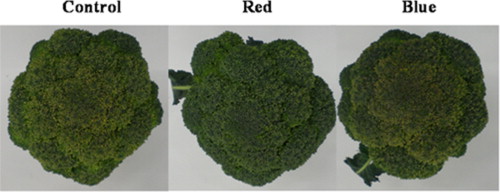Researchers from Department of Biological and Environmental Sciences, Faculty of Agriculture, Shizuoka University in Japan find in this latest study that broccoli aging after harvest can be delayed by red LED lights, while blue LED lights had no effect on countering the yellowing process. The study conducted by Gang Maa, Lancui Zhanga, Chandra Kurnia Setiawana, Kazuki Yamawakia et al. has been published in Postharvest Biology and Technology journal.
-
Broccoli senescence was delayed by red LED light, but not affected by blue LED light.
-
AsA reduction in broccoli after harvest was suppressed by red LED light.
-
A modified white light was designed, in which the ratio of blue light was decreased, while the ratio of red light was increased.
-
The modified white light was effective in delaying AsA reduction in broccoli on the first and second days after harvest.
 |
|
Comparison of senescence in broccoli after harvest under different color LED lights. |
Abstract
The effects of red and blue LED lights on the senescence of broccoli (Brassica oleracea L. var. italica) after harvest were investigated. The results showed that irradiation with red LED light was effective in delaying senescence in broccoli after harvest. Under red LED light, the yellowing process was delayed, and ethylene production and reduction of ascorbate (AsA) were suppressed in broccoli after harvest. In contrast, the blue LED light treatment did not significantly affect the senescence process of broccoli after harvest. As the red light is inconvenient for customers in selecting broccoli in the supermarket, we designed a type of modified white LED light. In this modified white LED light, the ratio of blue light was decreased, while the ratio of red light was increased. Under the modified white LED light, AsA reduction in broccoli was slightly delayed on the first and second days after harvest. Moreover, the modulation of AsA reduction by the modified white LED light treatment was highly regulated at the transcriptional level. The up-regulation of the AsA biosynthetic genes (BO-VTC2 and BO-GLDH) and AsA regeneration genes (BO-MDAR1 and BO-MDAR2) contributed to the higher AsA content in the modified white LED light treatment on the first and second days after harvest. The results presented might provide new strategies to improve the nutritional quality of broccoli after harvest.












